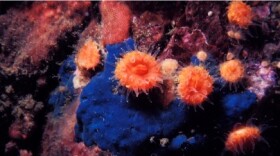There could be big changes on the horizon for the way the state of Washington manages its wolf population to minimize the conflicts between wolves and livestock.
For at least the last two summers, wildlife managers in Washington have had to shoot wolves that have killed or injured livestock. That practice has proven controversial, and in some cases dangerous for wildlife managers and ranchers.
This spring, state legislators allocated $300,000 for projects to manage wolves that keep them alive. The money is available in the four counties where the majority of Washington’s wolves roam. The first call for applications for grants went out in mid-October.
Dan Brinson has worked in conflict prevention and enforcement for the Department of Fish and Wildlife for three decades.
“We’re stepping into a new era where we are sort of partnering and coordinating with the Washington state Department of Agriculture and how to provide those measure out on the landscape,” Brinson said.
Brinson took part in a teleconference to brief members of the state’s Interagency Wolf Committee. The IWC was also briefed on actions taken to respond to livestock depredation pinned to four wolf packs in Northeastern Washington. The WDFW took action against two of those packs this summer.
Donny Martorello manages Washington’s wolf program. He reminded the IWC that WDFW received notice of litigation for their decision to shoot member of the Sherman wolf pack from a helicopter in northeastern Washington this past summer.
In September, the Center for Biological Diversity and Cascadia Wildlands filed a lawsuit against WDFW Director Jim Unsworth and one other WDFW employee. The groups argue the lethal removal action violates state law.
“As you can imagine, I don’t have a lot to say about it at this time,” Martorello said.
Committee members did not ask any further questions or offer comments about the suit. Martorello also told them the state is preparing for a time in the future when wolves will be removed from the state endangered species list.
“We know that we need to begin thinking about what conservation and management looks like in the post-delisting period,” he said.
Martorello said it may take up to five years for the state to either amend the current management plan or develop a new one. By then, he added, WDFW might find it has already met recovery objectives laid out for the return of wolves to Washington.
---
Correction: A previous version of this story said wolves were re-introduced into the state. According to wildlife officials, wolves are returning naturally from populations that had dispersed to other states. The story also indicated that lethal actions were taken against four of the state’s wolf packs this summer. Wildlife officials say lethal actions were taken against two of them.
Copyright 2017 Northwest News Network







